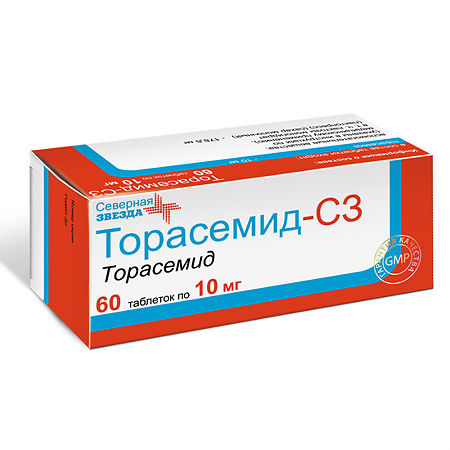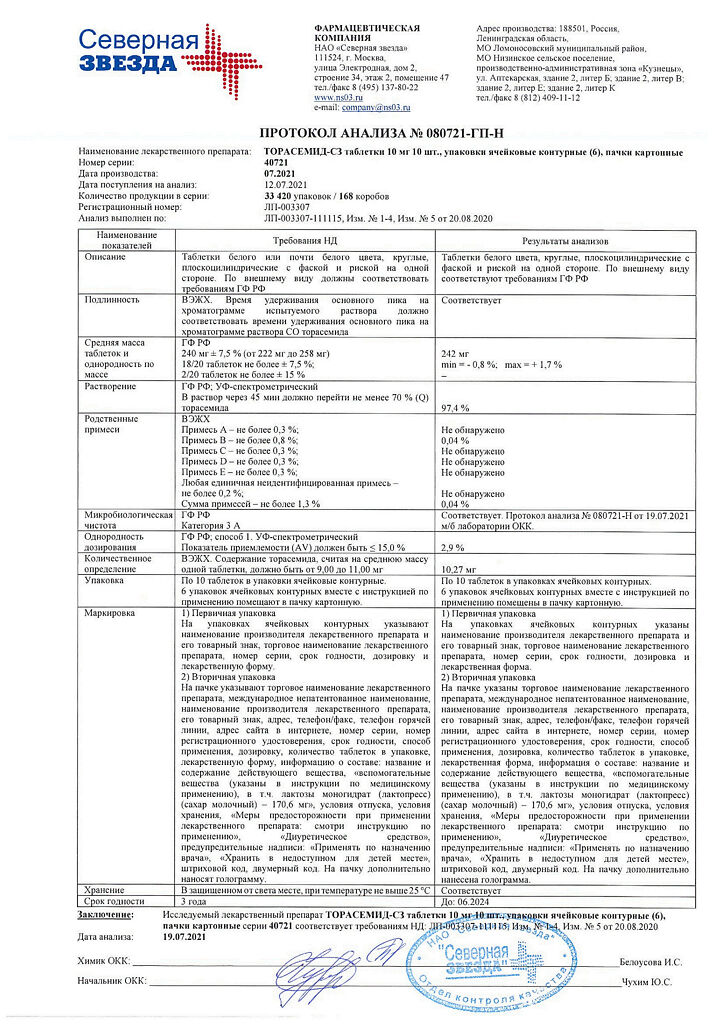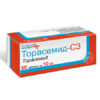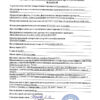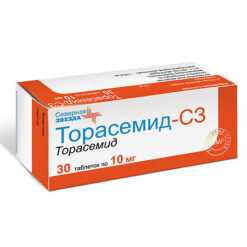No products in the cart.
Torasemide-SZ, 10 mg tablets 60 pcs
€9.37 €8.00
Description
Edema, Hypertension (high blood pressure), Heart failure
- edema syndrome of different genesis, including chronic heart failure, liver, lung and kidney disease
- arterial hypertension.
Active ingredient
Active ingredient
How to take, the dosage
How to take, the dosage
The drug is taken orally once a day, at any convenient (but at the same time) time, regardless of meals. The tablets should be swallowed without chewing and with plenty of water.
Oedema syndrome in chronic heart failure
The recommended starting dose is 10-20 mg once daily. If necessary, the dose may be doubled until the desired effect is achieved.
Oedematous syndrome in renal disease
The recommended starting dose is 20 mg once daily. If necessary, the dose can be doubled until the desired effect is achieved.
Oedematous syndrome in liver disease
The recommended starting dose is 5-10 mg once daily. If necessary, the dose may be doubled until the desired effect is achieved.
It is not recommended to exceed the maximum single dose, which is 40 mg (no experience with use).
The drug is used over a long period or until the edema disappears.
Arterial hypertension
The starting dose is 2.5 mg (1/2 tablet of 5 mg) once daily. If there is no therapeutic effect within 4 weeks, the dose is increased to 5 mg once daily. If there is no adequate BP reduction when administered in a dose of 5 mg once daily for 4-6 weeks, the dose is increased to 10 mg once daily. If use of 10 mg/day does not produce the desired effect, an antihypertensive agent from another group should be added to the treatment.
In older patients, no dose adjustment is required.
Interaction
Interaction
Increases the concentration and risk of nephro- and ototoxic effects of cephalosporins, aminoglycosides, chloramphenicol, etacrynic acid, cisplatin, amphotericin B (due to competitive renal excretion).
Effectiveness of diazoxide and theophylline increases, decreases effectiveness of hypoglycemic agents, allopurinol.
Presor amines and thorasemide mutually reduce the effectiveness of each other.
Drugs that block tubular secretion increase the serum concentration of thoracemide.
The simultaneous use of GCS, amphotericin B increases the risk of hypokalemia; with cardiac glycosides – the risk of glycoside intoxication due to hypokalemia (for high- and low-polar) and prolongation of T1/2 (for low-polar) increases.
Decreases renal clearance of lithium preparations and increases the likelihood of intoxication.
The NSAIDs, sucralfate decrease diuretic effect due to inhibition of prostaglandin synthesis, impairment of plasma renin activity and aldosterone excretion.
It increases the antihypertensive effect of hypotensive drugs, neuromuscular blockade of depolarizing myorelaxants (suxamethonium) and weakens the effect of nondepolarizing myorelaxants (tubocurarine).
The simultaneous use of salicylates in high doses with torasemide therapy increases the risk of their toxicity (due to competitive renal excretion).
The sequential or simultaneous use of thorasemide with ACE inhibitors or angiotensin II receptor antagonists may lead to a significant decrease in BP. This can be avoided by reducing the dose of thorasemide or temporarily cancelling it.
The concomitant use of probenecid or methotrexate may decrease the effectiveness of thorasemide (same secretion pathway). On the other hand, thorasemide may lead to decreased renal elimination of these drugs.
The simultaneous use of cyclosporine and thorasemide increases the risk of gouty arthritis due to the fact that cyclosporine may cause impaired urate excretion by the kidneys and thorasemide may cause hyperuricemia.
It has been reported that patients at high risk of nephropathy taking oral thoracemide were more likely to have impaired renal function when given radiopaque agents than patients at high risk of nephropathy who underwent IV hydration before radiopaque agent administration.
The bioavailability and, consequently, the effectiveness of thoracemide may be reduced by co-therapy with colestyramine.
Special Instructions
Special Instructions
The drug should be used strictly on prescription.
Patients with hypersensitivity to sulfonamides and sulfonylurea derivatives may have cross-sensitivity to Torasemide-SZ.
Patients receiving Toracemide-SZ at high doses for a prolonged period are recommended a diet with sufficient content of table salt and use of potassium preparations to avoid development of hyponatremia, metabolic alkalosis and hypokalemia.
The increased risk of water-electrolyte balance disorders is noted in patients with renal insufficiency. During the course of treatment it is necessary to monitor the concentration of plasma electrolytes (including sodium, calcium, potassium, magnesium), acid-base status, residual nitrogen, creatinine, uric acid periodically and provide the appropriate corrective therapy if necessary (with higher frequency in patients with frequent vomiting and with parenterally administered fluids).
If azotemia and oliguria appear or worsen in patients with severe progressive renal disease, it is recommended to suspend treatment.
Patients with ascites against liver cirrhosis should be dosed under hospital conditions (electrolyte-water balance disorders may lead to hepatic coma). Regular monitoring of blood plasma electrolytes is indicated for this category of patients.
In patients with diabetes mellitus or with reduced glucose tolerance, periodic monitoring of blood and urine glucose concentrations is required.
In unconscious patients with prostatic hyperplasia, ureteral narrowing, diuresis control is necessary due to the possibility of acute urinary retention.
Influence on driving and operating machinery
Patients must refrain from driving and engaging in other potentially dangerous activities that require increased concentration and quick psychomotor reactions (risk of dizziness and somnolence) during treatment.
In renal failure
The drug is contraindicated in renal failure with anuria, acute glomerulonephritis, acute urinary outflow disorders of any etiology (including unilateral urinary tract involvement).
With cautiousness the drug should be used in case of urine outflow disorders (benign prostatic hyperplasia, narrowing of the urethra or hydronephrosis), hepatorenal syndrome.
In case of liver dysfunction
The drug is contraindicated in hepatic coma and precoma.
The drug should be prescribed with cautious in hepatorenal syndrome.
Children
In older patients no dose adjustment is required.
Contraindications
Contraindications
Side effects
Side effects
The incidence of side effects is classified according to World Health Organization recommendations: very frequently, â¥1/10 (>10%); frequently, â¥1/100 to <1/10 (>1% and <10%); infrequently, â¥1/1000 to <1/100 (>01% and <1%); infrequent – â¥1/10,000 to <1/1000 (>0.01% and <0.1%); very rare – <1/10,000 (<0.01%); frequency unknown – cannot be estimated from available data.
Nervous system disorders:often – headache, dizziness, somnolence; infrequent – muscle cramps of the lower extremities; frequency unknown – confusion, fainting, paresthesias in the extremities (feeling of numbness, “creeping” and tingling).
Senses: frequency unknown – visual impairment, hearing impairment, tinnitus and hearing loss (usually reversible) usually in patients with renal failure or hypoproteinemia (nephrotic syndrome).
Cardiovascular disorders: infrequent – extrasystole, arrhythmia, tachycardia; frequency unknown – excessive BP decrease, orthostatic hypotension, collapse, deep vein thrombosis, thromboembolism, reduction of BOD.
In the respiratory system: infrequent – nasal bleeding.
From the digestive system: frequent – diarrhea; infrequent – abdominal pain, flatulence, polydipsia; frequency unknown – dry mouth, nausea, vomiting, loss of appetite, pancreatitis, dyspeptic disorders, intrahepatic cholestasis.
Urinary system disorders:often – increased frequency of urination, polyuria, nycturia; infrequently – frequent urge to urinate; frequency unknown – oliguria, urinary retention (in patients with urinary tract obstruction), interstitial nephritis, hematuria.
Concerning the reproductive system: incidence unknown – decreased potency.
Skin and subcutaneous tissue disorders: frequency unknown – skin itching, rash, urticaria, erythema polymorphic, exfoliative dermatitis, purpura, vasculitis, photosensitization.
Muscular system disorders: frequency unknown – muscle weakness.
Metabolism: incidence unknown – hypokalemia, hyponatremia, hypomagnesemia, hypocalcemia, hypochloremia, metabolic alkalosis, hypovolemia, dehydration (more often in elderly patients).
Laboratory parameters: infrequent – hypercholesterolemia, hypertriglyceridemia; infrequent unknown – hyperuricemia, slightly increased plasma ALP activity, increased plasma creatinine and urea concentrations, increased plasma activity of some liver enzymes (e.g., GGT), thrombocytopenia, leukopenia, agranulocytosis, hyperglycemia, decreased glucose tolerance (possible manifestation of latent diabetes).
Others: frequency unknown – aplastic or hemolytic anemia.
Overdose
Overdose
Symptoms:Elevated diuresis accompanied by a decrease of the CIC and disturbed water-electrolyte balance of the blood, followed by an excessive decrease in BP, drowsiness and confusion, collapse. Gastrointestinal disorders may be observed.
Treatment:There is no specific antidote. Provocation of vomiting, gastric lavage, activated charcoal. Symptomatic therapy, dose lowering or drug withdrawal and simultaneous refilling of the blood circulation and parameters of water-electrolyte balance and acid-base status under control of serum concentrations of electrolytes, hematocrit. Hemodialysis is ineffective.
Similarities
Similarities
Additional information
| Shelf life | 3 years. Do not use after the expiration date printed on the package. |
|---|---|
| Conditions of storage | In a dry, light-protected place at a temperature not exceeding 25 oC. |
| Manufacturer | North Star NAO, Russia |
| Medication form | pills |
| Brand | North Star NAO |
Other forms…
Related products
Buy Torasemide-SZ, 10 mg tablets 60 pcs with delivery to USA, UK, Europe and over 120 other countries.

